PARIS NAVIGO PASSES – THE BEST WAY TO EXPLORE THE CITY, AND BEYOND. HOW TO GET AROUND PARIS LIKE A LOCAL
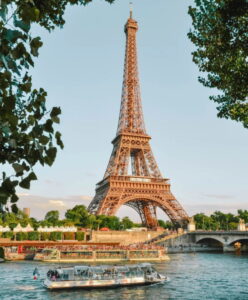
About 5 or 6 years ago, I wrote a blog story about the Paris Navigo Pass and its uses. It is indeed the only way to get around Paris these days. Since then, its use has expanded to include the relatively new tram system that circles the city. I know from conversations I have with friends and colleagues that there are still many visitors who don’t know about this transport card, or only restrict themselves to using it on the metro trains. Somehow, they don’t tend to use the bus system, or extend their travels to explore the outer edges of Paris. In response to a number of enquiries to demystify the Navigo network, I’ll explain how it all works.
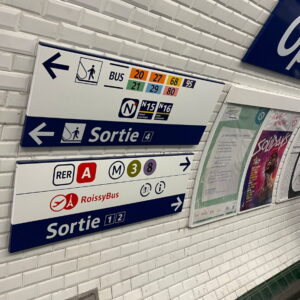
As we all know, many cities around the world have a transport swipe card, to avoid the necessity of purchasing a ticket for every ride, and enhance the flow of passengers on their networks. London has its Oyster card, Sydney its Opal Card, Hong Kong the Octopus Card. All these systems have one thing in common: they are distance-based, meaning that the further each individual journey, the more it costs, which is deducted from the stored balance on the card. The convenience factor still makes them worthwhile, which is why everyone, either resident or visitor, acquires one. To encourage the take-up of a city’s card system, there’s often, but not always, a saving instead of buying individual tickets for every journey.
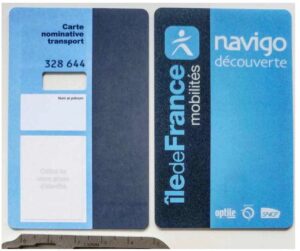
Paris, as you are probably aware, has its own transport swipe card, the Paris Navigo Pass, as well as the Navigo Decouverte Pass and now, the new Navigo Easy Pass. Officially, the difference between them is that the Navigo Pass is supposedly for locals, whereas visitors are encouraged to purchase the Navigo Decouverte Pass. I have never been able to discern a difference, and the Navigo Pass is the only one we’ve ever had, and we’re not full-time residents, so henceforth, I’ll simply refer to it as the Navigo Pass. The cost is the same, including the initial 5 Euros to purchase it. From then on, it’s simply a matter of topping it up at one of the machines at any metro station.
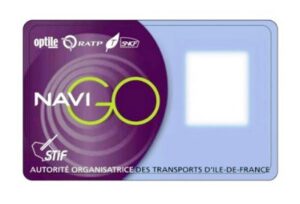
To purchase the Navigo, you will need to have a passport-sized photo of yourself. If you don’t have a spare, or forget to take it to Paris, virtually every metro station has at least one of those little photo booths, since the French require photo I.D. for many services, as well as the transport card.

The Pass has an upfront, one-off fee of 5 Euros to purchase it, then add the fee for the duration you nominate—weekly, monthly. You take your photo and 5 Euros to the ticket window for the staff member to process it, it’s not done at the machine. However, when you need to top it up, you do it on one of the machines. These take credit cards of course, as well as cash.
As of a few months ago, it’s now possible to download Navigo Passes on Android smartphones using the Ile-de-France Mobilités app. to load your ticket. However, I’ve read a few comments from users saying that they couldn’t locate the download on their phones. It seems that with some brands of phone, it’s a bit hit ‘n miss. Probably for now though, it’s safer to simply buy the Pass from a metro station—at least until the bugs are ironed out of the system.
Now, as with many things, there’s a downside to the Navigo Pass. Although its use allows unlimited travel for its duration, it is for 7 days use, Monday – Sunday. You can argue that this makes no sense (agreed!), that it shouldn’t matter which day of the week you start from, 7 days duration is still 7 days. However, we’re stuck with the facts as it stands. You can though, purchase it up until the Wednesday of that week, but from then until Sunday, you must buy a Navigo Jour (day) pass, which offers unlimited 24-hour travel, or individual tickets to tide you over. No big deal, but a nuisance. As I say, it makes no sense.
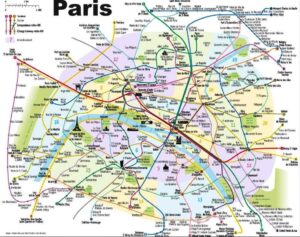
When you purchase it, the staff member, and from then on, the machine, will want to know how many zones you want the Pass to cover. We always go for the maximum, i.e., up to and including zone 5. The cost for only zones 2 to 3 is only marginally cheaper, and in our view, it’s simply more convenient to have the maximum allowed, as you might not know just how far you want to explore. The fact you’ll have unlimited travel will hopefully encourage you to spread your wings and go to areas you might not have ventured to before. Right now, the cost for all 5 zones is 30.75 Euros for a week and 86.40 Euros for a month, while zones 2 – 3 costs 28.20 Euros for a week and 78.80 Euros for a month, plus the initial 5 Euros to buy it.
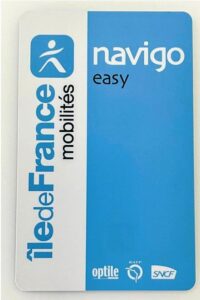
By way of some recognition of the shortcomings of the Navigo Pass, just a few months ago, a new Pass was introduced, the Paris Navigo Easy. This Pass allows you to top up just a single trip, a full price or reduced-price set of 10 trips, on this one Pass card. The Navigo Easy Pass is sold for 2 Euros, plus the number of rides you want, up to 10 at a time. Note that you don’t need a photo of yourself for this Pass. You place the Pass against the card reader at the metro, on the bus or tram. It seems to us that the introduction of this Pass indicates perhaps that the Paris Visite Card may be soon phased out. This is a very useful Pass to acquire if you arrive in the city during the week, before you can purchase the full Navigo Pass or Navigo Decouverte Pass.

At this point, it’s time to discuss just how far from the city the Navigo Pass covers. As well as within the city limits, i.e., within the Périphérique ring-road, the Pass extends out to the Ile-de-France areas. You can enjoy any number of great day trips out of the city using your Navigo. I’ve written about a couple of excursions on earlier blogs, such as to Fontainebleau, Versailles, the Parc de Seaux, Château de Malmaison, Château de Champs-sur-Marne, Vaux le Vicomte, and Auvers-sur-Oise (where Van Gogh spent his last year and where he’s buried), among other great destinations that are perfect for a day’s excursion. Check out these particular destinations on earlier blogs. You can also go out to Disneyland using a Navigo Pass.

We use a combination of metro and buses for such excursions as a day out to the Marché aux Puces de Paris Saint-Ouen (to give it the full, official name) out at Clignancourt. We take Line 4 metro to its terminus at Porte de Clignancourt, and following the crowd, walk from the metro station towards the market, passing under the motorway, the Bvd Périphérique, and stroll from the beginning of the market precinct—the biggest in Europe—into the sections of this vast area that we’ve come to explore. When we’re done—and by this time, usually very weary—rather than retrace our steps to the metro, we take a no. 85 bus from rue des Rosiers on the edge of the market, and ride all the way to Chatelet, down by the river, passing through areas of the city we would not otherwise have a reason to go to. A delightful way to recover from our exertions around the flea market.
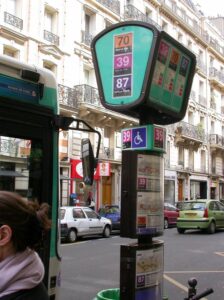
Thinking of buses, many visitors feel a little intimidated about using the bus network. This is a pity, since it’s a great way to see the city on your journey, rather than taking the metro (which may indeed be quicker), where you simply pop up to ground level after an underground trip, without having the least idea about the neighbourhoods you’ve travelled under, or features such as monuments or landmarks. We have a friend who often picks a bus route, pretty much at random, hops on and goes right to the end of the line, and takes it back again, perhaps alighting in an area of interest that she had noticed on the way out. A great, very inexpensive way to explore the city since it does not cost extra to travel a longer distance—one stop or 20, it doesn’t matter.
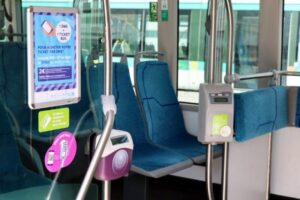
At each bus stop there is a route map marking every stop, so it’s easy to see where you’re headed. If you have a bus map booklet, it’s so easy to plot a route for the day. You can see where bus lines overlap, which is also an aid to plotting a route. Sometimes, it’s more efficient to take a combination of metro and buses, and there are always bus stops near metro stations. With the buses, you get on at the front, and next to, or near, the driver is the round, plum-coloured plate where you tap your Navigo on entering. There’s an electronic sign hanging from the bus ceiling, as well as route maps on the wall for you to follow your journey and know when to get off. You exit buses from the middle door, not the front again, which keeps the passenger flow moving more efficiently. We use buses a lot, simply because it’s more pleasant and when time isn’t particularly an issue. As well, buses can sometimes be closer to your destination than a metro stop.

The tram network has existed since the early 1990s, and services the outer edges of the city. One of the main ideas behind it was to alleviate the need for people in outer areas having to come closer to, or right into the city, and probably change metro or bus lines, in order to catch transport to an area of Paris outside the immediate inner city, say for work purposes. There are now 13 tram lines, the first one in the system being the Saint-Denis – Bobigny line. A second line appeared in 1997, the Coteaux line, servicing the Hauts-de-Seine. Two others opened in 2006, one marking the return of the tramway in Paris and a line in Seine-Saint-Denis. Since 2010, several additional lines were planned, which also mark the arrival of the rubber-tyred trams.

Admittedly, most visitors won’t need to use the tramway, and one of the few times we used it was on a recent visit, when we caught it to visit the Museum of the History of Immigration, housed in an Art Deco masterpiece, the former Palais de la Porte Dorée at avenue Daumesnil in the 12th arr. The tram stop on Line T3 is just a few minutes’ walk from the museum, and we used it again after our visit and got off at Porte d’Italie to catch the Line 7 metro back to our apartment. Like the buses, you tap onto the round card reader plate in the carriage to register your journey, but you don’t tap off, as with all other methods of Parisian transport, it’s not distance-based. It was just a very pleasant novelty being above ground rather than down in the metro. If you do a Google search, you’ll find tramway maps to download. It has been a very popular, and practical move, to help eliminate unnecessary congestion within the city’s public transport system.

A few things to bear in mind with the Paris Navigo Pass. It’s valid to use on the Montmartre Funicular, and you can use it to go out to Charles de Gaulle airport, but for some unaccountable reason it’s not valid on the Orlyval, which is the automatic shuttle train serving Orly airport. If you wish to take public transport to Orly, you can take the Orlybus, which departs from metro station Denfert-Rocherau (lines 4 and 6). To go to CDG airport, you can take either the metro or the Roissybus, all of which are available using the Navigo. If you are only in Paris for a few days, the Paris Visite Pass has been the card to obtain, and it’s available for periods of 1, 2, 3 and 5 days. However, as mentioned above, it seems that the new Navigo Easy Pass may be replacing it. After that duration, the Navigo Pass is the way to go.
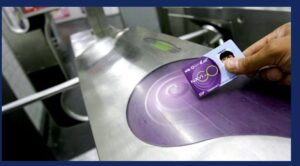
So: armed with your bright, new Navigo Pass—whichever version you decide is appropriate for you—as well as both a metro and a bus map, it’s time to confidently sally forth and explore the city.



Wow Cheryl
What amazingly helpful information you have given us. Thank you.
Not everyone has a seasoned Parisienne by their side when purchasing their first Navigo!!
I am keeping that information for my (hopefully) next visit.
Merci beaucoup
Bonjour Pam,
Many thanks for your kind words of praise. I’m so glad you fond the info helpful, and that’s exactly why I wrote it. I’ve had many people in the past asking about how to get around Paris by public transport, without getting stressed, or wasting time, especially as visitors have such limited time, and just want to get on with it. Thanks once again! xx Cheryl
Tres Interessant Cheryl,
My wife Anne is recovering from back surgery and often needs to use a 4-wheel walker when she is in busy public spaces – as much as a signal to others as for mobility/stability. At other times she can use a walking stick, with my assistance in tricky situations. What is the situation with accessibility for people like Anne on Parisian public transport? We would love to return again to Paris, but are not sure of our ability to get around the city (and the country generally).
Steve
Hi Steve,
Yes, I can appreciate how difficult it is to negotiate travel with a disability, especially for those of us for whom travel is as essential as breathing! Regarding Paris, it’s an issue ponder about, given that the Olympics are this year, starting 26 July, I think it is, not so much for the able-bodied, but for those with a disability who are very keen to especially attend some of the Para-Olympic events. We attended some Para events at the Sydney Games back in 2000, and they were so inspiring. Realistically, I would say with Paris, that you can forget the metro, which I imagine you’ve already assumed. Even though some metro stations have escalators to/from street level, there are still staircases to negotiate to get to and from individul platforms. This also holds true of most of the mainline stations, although quite a lot of these stations have escalator access to platforms as well as within the station complexes. The buses, on the other hand, deal well with disabled passengers, better than a lot of other countries–perhaps in part as recognition of the reality of the train system for the disabled? Who knows. They virtually all have that platform that extends out from the bus and tilts towards the footpath, which having watched disabled passengers alighting from and into a bus, works well, and other passengers seem to be respectful of the little extra time taken to accommodate the disabled–as indeed they should! We’ve also seen these tilting access ramp buses in regional areas. The new-ish tram system would also probably work well for the disabled, as access onto the platforms is easy with ramps at at least one end, and the carriages themselves on platform level–at least, in our experience. Even though they are very used to huge influxes of visitors for special events, I think it will be very good for Parisians to experience the Olympics which will attract such a wide range of visitors with varying needs. I’ll also bet that this experience will see an enhancement of services for the disabled further down the track, right across the country. We will all be very keen to see the after-effects of the Olympics across many areas of daily life.
Regards, Cheryl
Comme toujours, ce sont d’excellentes informations et j’adore vos publications.
Merci beaucoup for vos mots tres gentils Brian. Je suis tellement content que vous appreciiez les histories et, esperons-le, que vous les touviez utiles ors de vos propres voyages. Cordialement, Cheryl